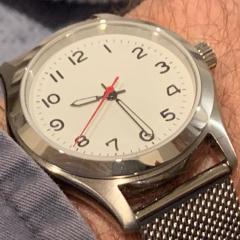-
Recently Browsing
- No registered users viewing this page.
-
Topics
-
Posts
-
By nevenbekriev · Posted
Ok, with the parts You have, the easiest thing to do is vibrate a new hairspring, of cousre for 16800 BPH. A couple of balance screws will be not enough, at least 3-4 aditional couples will be needed. And this if You have that many free holes. And cutting 75 teeth table for the contrate wheel is the other reasonable option Different things may have happened to the clock - the contrate wheel may have be replaced from another modification, the platform may not be original, the hairspring may have been replaced and vibrated for 18000 or the entire balance may have been replaced wit the wrong one... -
I also agree with @mikepilk and @Waggy. Your readings look good. The amplitude drop between the horizontal postion and the vertical position is nice and low (only 18° difference). The delta of 17 sec (-3 to +14) between those positions is absolutely ok. If you really wanted to improve on this, I think you'd have to look into the poising of the balance wheel (not the spring, which looks perfect). But that's a total overkill for this kind of movement. Leave it be.
-
I've just finished refurbishing a Memostar Alarm with AS 1931 movement (same as 1945 but with date and running at 21600). I was also surprised how many parts are available at Cousins. Like you, I was missing the alarm stem (Cousins stock them) and I needed new crowns. It's a nice simple movement for an alarm, easier to service than a Seiko Bell-Matic. BTW I made a note in my Servicing spreadsheet: "Pull out winding stem before removal". It may have just been wear on my movement, but I found that the yoke could move out of the clutch if the stem was removed in the normal position (like some ETAs). You might find this interesting
-
By LittleWatchShop · Posted
I picked up this alarm watch at a flea market several months ago and recently decided to investigate. I am not finished, but well on my way. As you can see, there was significant water damage. Running these parts through my L&R cleaner was not enough to clean them, so I did manual cleaning with one-dip and cotton swab (the dense pointed kind). The wig-wag was stubborn--the two gears would not release from the plate. I soaked it in Kroil overnight and that did the trick. There was some rust on the balance staff, but not actually on the pivots themselves. Nevertheless, I chucked it a step-chuck on my lathe and burnished the pivots. The watch is running and I have confirmed that the alarm drive train is functioning. Since I am missing a stem for the alarm, I have not done the final assemble of the alarm components. Surprisingly, there are lots of parts available for this movement on Cousins. I will probably get a couple of stems and maybe some other parts that I deem necessary. The watch is running at weak amplitude (about 190) and shows some poising issues. I will work on that. The last two pictures are after partial reassembly.
-




.thumb.jpg.cb17a66989f1e796fd4217db2e9ca9df.jpg)

Recommended Posts
Join the conversation
You can post now and register later. If you have an account, sign in now to post with your account.
Note: Your post will require moderator approval before it will be visible.